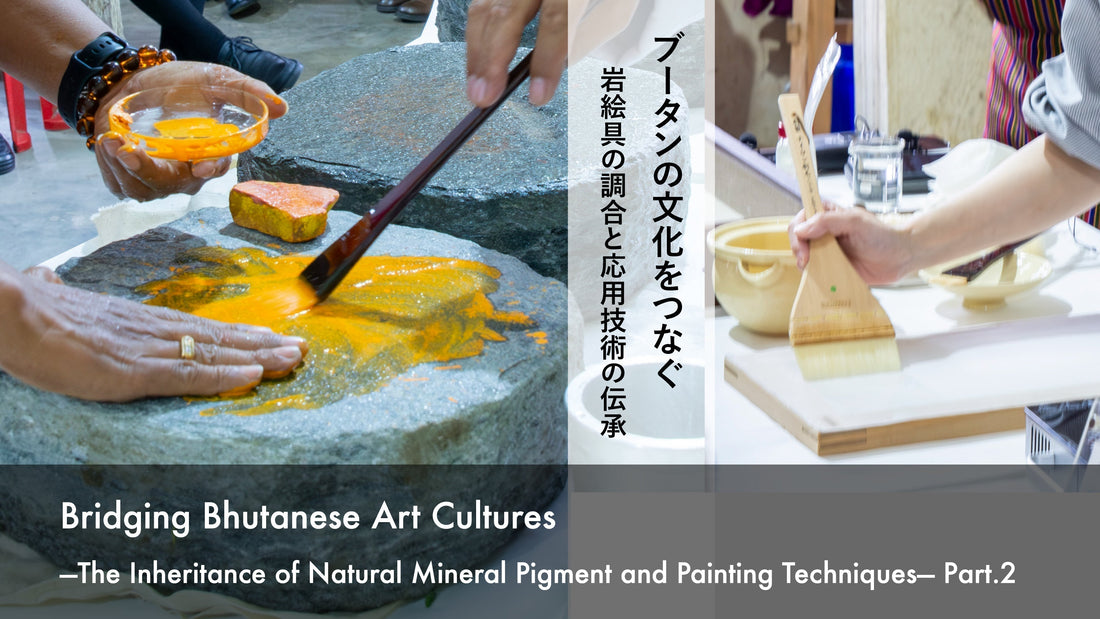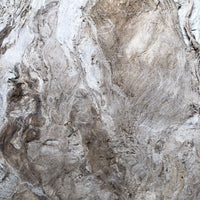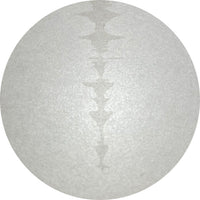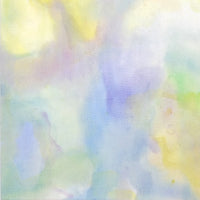PIGMENT TOKYO supports artists through various projects by sharing knowledge on traditional Japanese art techniques and materials such as mineral pigments, animal glue, and so on.
In September 2024, PIGMENT TOKYO was invited by the Department of Culture and Dzongkha Development (DCDD), a government organization of the Kingdom of Bhutan, to give lectures and demonstrations under the workshop program titled “Mineral Pigment Paint Preparation and Application Techniques.”
This workshop program started out as a part of the Tango Monastery restoration project, which is one of the most important DCDD's restoration projects. The background of this project is deeply related to the current situation of art materials in Bhutan.
It was led by Tashi Lhendup, who works for the DCDD as a restorer and a leader of the restoration project who respects Bhutanism.
Throughout the program, we also had a great opportunity to learn about the technical usage of mineral pigments in Bhutan and Nepal.
In the previous article, we introduced the background of the workshop program, its purpose and the art and culture of Bhutan. In this article, we will focus on what we learned from each workshop.
*Dzongkha... Official language of Bhutan. It is an important and symbolic element of Bhutanese culture and identity. It is deeply connected with Bhutanese Buddhist culture and has its unique writing system while belonging to the Tibetan family of languages.
Workshop Program
Bhutan
Title: Mineral Pigments Used on Murals in the Tango Utsi
Instructors:
Tashi Lhendup, Conservator of the DCDD (Division For Cultural Properties)
Dasho Karma Ura, the President of the Centre for Bhutan Studies and GNH (Gross National Happiness) Research / Artist

Left: Tashi Lhendup / Right: Dasho Karma Ura
Image courtesy of DCDD
The project leader, Tashi Lhendup, gave a lecture on the restoration of Tango Utsi, while Dasho Karma Ura gave a presentation about color theory.
The lecture covered a wide range of topics with slide presentations. It was based on Tango Utsi (a pagoda) but also discussed natural pigments used in ancient times and the relationship between pigments and colors.
In Bhutan, there is a painting style known as Thangka. The Tango Utsi preserves many ancient Bhutanese Thangka murals painted in the 17th century in the Menlug style, which is a traditional Bhutanese painting style.
The original murals and frescos were painted approximately 300 years ago using natural mineral paints, paints made from madder and natural lacquer with delicate gold gilding. The style is characterized by colorful and intricate designs, and the level of detail demonstrates the high skill of Bhutanese artists.
Most artworks in Bhutan primarily consist of Buddhist paintings and statues which are known for their vivid colors, intricate designs and detailed expression. While there are some contemporary artworks that feature abstract expressions, the motifs generally revolve around Buddhist figures. As a result, these artworks are closely intertwined with religious beliefs and are created as a form of worship.
Zorig Chusum, which refers to 13 genres of traditional arts and crafts, including the art of building with mortar and plaster, called Jinzo, and Tango Utsi is home to numerous Zorig.
For more information on the restoration of Tango Utsi, check out the following video.
*Narration..Dzongkha / Subtitle...English

Left: The back of a canvas / Right: Thangka painted on a canvas
Monastery thangkas are painted directly on the wall, but the general thangka paintings are on cotton canvas, which can be carried around like a scroll. The painting will then be decorated as a decorative fabric or hung from the wall like a hanging scroll.
As you can see from the picture, it is different from the regular canvas and stretching technique commonly practiced today. The edges of the cotton canvas are folded over and kinked, then braided with string and stretched over the frame.

Bhutanese animal glue (raw materials unlisted) and paintbrushes
The image above shows Bhutanese animal glue commonly used for paper mache masks.
Although animal glues have differences in manufacturing methods and raw materials depending on the climate and culture, they have been used in many regions of the world.
Since ancient times, binders made from animal collagen have been used in various places.
Furthermore, there are no conventional art supply stores in Bhutan. Pigments and most painting materials are imported from India and Nepal, and only a few types of brushes are available, so most artists make their own brushes from raccoon dog and cat hair.
Nepal
Title: Basic Knowledge and Usage of the Nepalese Mineral Pigment
Instructor: Sudarshan Suwal, Pauva Expert / Artist

Sudarshan Suwal
Pauva expert Sudarshan Suwal gave a lecture and demonstration on basic information and the use of Nepalese mineral pigments.
Suwal is a Newari artist who specialises in Pauva painting techniques.
He is known for traditional Buddhist and Hindu-style paintings, which reflect his deep understanding and respect for the Newar culture.
He also contributes to the preservation and dissemination of traditional art by teaching how to paint Pauva and explaining its cultural significance.

Demonstration of grinding pigments
Image courtesy of DCDD
Pauva is a painting technique that has been passed down among the Newars living in the Kathmandu Basin of Nepal and is said to be the precursor of Tibetan Thangka. For this reason, Pauva is sometimes referred to as Thangka, and it is related to artists and restorers in Bhutan.


〈Demonstration〉Crushing down natural azurite with a metal muller.
PIGMENT TOKYO offers marble stone board and glass mullers (paint kneading tool), but paints can also be made with other types of tools.

IIron oxide pigments
Image courtesy of DCDD
Natural mineral pigments are also used in Nepalese Pauva painting.
Suwal demonstrated how to make pigment powder from the ores.

Image provided by DCDD

〈Demonstration〉Grinding a pigment block on the wetted stone slab.
Until the 17th century, Thangka paintings were created using colors extracted from minerals, plants, flowers etc. The process of making paints from these natural sources is extremely time-consuming and labor-intensive.
It is said that painters of that era would meditate and pray before painting to enhance their concentration. This practice, along with the process of creating paints, may have also helped the artists focus on themselves and their creative process.
Since natural minerals can be mined in Nepal, these materials were likely familiar and accessible options for the artists.

After this process, the ground pigments were kneaded with animal glue in a mortar to make Nepalese-style paints.


Japan / PIGMENT TOKYO
Title: Japanese Iwa-enogu (Mineral Pigments) and Traditional Painting Techniques
Instructors:PIGMENT TOKYO Natsumi Yamasato (Instructor)/ Atsumi Okano(Interpreter)
PIGMENT TOKYO was responsible for lectures and demonstrations on pigments, glue, ink and painted silk. The lecturers were Yamasato, who holds workshops on traditional Japanese painting and techniques, and Okano, who is responsible for English translations for private workshops and articles.
◾️Pigment・Iwa-enogu (Mineral Pigment)

PIGMENT TOKYO’s staff giving a lecture about pigment
Left: Natsumi Yamasato / Right: Atsumi Okano
Image courtesy of DCDD
Pigments: Indigo, Lapis Lazuli, Natural Gunjo, Natural Matsuba Rokusho, Natural Kicha, Natural Akacha, Natural Shinsha, Shin-iwa Asagi Gunjo, Shin-iwa Yamabuki, Cadmium Yellow Orange
In the first part, they focused on the difference between pigments and dyes; the binders (painting mediums) used in paints and the characteristics of painting materials according to the properties of binders.
In the traditional Thangka paintings, natural inorganic pigments and earth pigments such as ochre were used. Notable examples include lapis lazuli, azurite and malachite for blues; and chalk (calcium carbonate) for the foundational layer.
Based on this, the birth of artificial pigments was explained in conjunction with the details of natural mineral pigments. For example, Shin Iwa-enogu (artificial mineral pigments) are produced using a process similar to natural mineral pigments. However, they are made from tinted glass that is created by firing glazes and metal oxides at high temperatures.
Thus, we believe that understanding the manufacturing process of pigments can provide valuable insights from a different perspective.
Next, they explained the labeling numbers used to classify the grain sizes, which is the most distinctive and unique feature of Japanese mineral pigments. Minerals are crushed and divided into 10 different particle sizes. The color tone (brightness) changes according to the grain size, and the finer the particles, the brighter the color.

〈Demonstration〉How to knead mineral pigments with animal glue
Image courtesy of DCDD
◾️Basic Information on Animal Glue / Use of Mineral Pigments
After deepening our understanding of paints and pigments, it is time for animal glue, which is the essential material for mineral pigments.
In Bhutan, animal glue was traditionally used as a binder for natural pigments to make paints. However, today, acrylic paint has become a more common option.
Since animal glue is not widely known among many artists and restorers these days, lectures and demonstrations were held on how to prepare animal glue using a Japanese clay pot, how to knead it with mineral pigments and how to remove glue from kneaded paints.
PIGMENT TOKYO provides detailed information on the physical properties of animal glues sold in stores.
These properties include viscosity (mPa・s), jelly strength (JS/g) and pH (ph/hydrogen ion concentration). The jelly strength is particularly important because different types of animal glue serve various purposes and may need to be adjusted accordingly.
Moreover, the ideal physical properties and concentration of animal glue vary between its use for Iwa-enogu (mineral pigments) and dosa (a sizing solution used to prevent bleeding). The concentration also varies depending on the substrates, such as Washi paper and silk canvas.

〈Demonstration〉 Preparing animal glue
Image provided by: DCDD

◾️Painting Techniques on Silk Canvas / How to Stretch Silk Canvas and Apply Dosa Sizing
In Bhutan, silk canvas is not commonly used as a painting substrate. To address this, PIGMENT TOKYO conducted demonstrations on how to stretch silk on wooden frames and how to use agar fish glue as sizing. They also showcased a unique painting technique on silk canvas called Ura-zaishiki, which involves coloring from the backside of the silk.

〈Demonstration〉How to prepare sizing liquid from agar
Image courtesy of DCDD
Eginu is a raw, unrefined silk canvas made from woven threads of silkworm cocoons.
Depending on the color material, the application method and usage, it is possible to create a surface that highlights the translucency and natural beauty of the silk.
Typically, Eginu features a plain weave with a smooth surface. Sometimes the technique known as Kantenbiki is used to halt the grain before applying the dosa solution.
Kantenbiki is about applying an agar solution to the silk canvas to fill in the mesh created by the silk threads and smoothen the surface. This agar solution is made by boiling agar in hot water and then straining it. It should be applied to the silk surface with a flat brush while the solution is still hot. Once the surface has completely dried, a dosa solution can then be applied.
For more information about dosa sizing, please check out the following article.

〈Demonstration〉Applying dosa solution on the silk surface
The conventional dosa solution is created by mixing animal glue, alum and water.
In this mixture, the animal glue forms a film on the substrate, while alum is added to harden the film. The concentration of alum can be adjusted to influence the sizing effect and water repellency. However, increasing the amount of sizing can lead to issues, as acidic alum may cause oxidative deterioration and discoloration of the substrate.
On the other hand, animal glue with high jelly strength can solidify a film without using alum and it provides sufficient sizing effects on its own.
PIGMENT TOKYO recommends Fish Glue or Pig Skin Glue (Suitable for Dosa/Sizing) with high jelly strength for dosa application from the point of view of protecting and preserving artwork.

〈Demonstration〉 Painting with mineral pigments on a silk canvas
Image courtesy of DCDD
◾️Sumi Ink/Tarashikomi
In Bhutan, although it is common to use a carbon-based black pigment made from bones, Sumi ink has not been widely practiced. As a result, many participants in the workshop experienced the preparation of Sumi ink on an inkstone for the first time.
Lhendup from DCDD requested a demonstration of a Japanese painting technique known as Tarashikomi.
Tarashikomi is a wet-on-wet technique where a second color is dripped onto the surface before the first color dries, creating a marble-like effect.

〈Demonstration〉 Tarashikomi technique

Image courtesy of DCDD
The Tango Monastery project is expected to continue over the next 10 years.
As this workshop program is a starting point, PIGMENT TOKYO will continue this important relationship and keep exchanging our cultures through sharing knowledge of materials and techniques such as mineral pigments, animal glue and Sumi ink.

Image courtesy of DCDD
PIGMENT TOKYO
Private Workshop Information for Corporate and Group Customers
Basic information about private workshops (individuals, corporations, and organizations) is available in the following article.
Reference Links
Bhutan
Department of Culture and Dzongkha Development (Ministry of Culture, Dzongkha Ministry of Development)
Bhutan Basic Data | Ministry of Foreign Affairs
Nepal
Sudarshan Suwal
Natural Collection Traders http://www.stonepigments.com/
Instagram https://www.instagram.com/sudarshan_suwal/
Translated by Atsumi Okano, Nelson Hor Ee Herng
PIGMENT TOKYO Art Materials Experts















